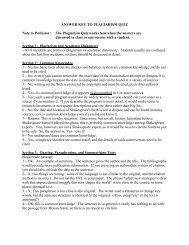2013â2014 The Bulletin - USS at Tufts - Tufts University
2013â2014 The Bulletin - USS at Tufts - Tufts University
2013â2014 The Bulletin - USS at Tufts - Tufts University
Create successful ePaper yourself
Turn your PDF publications into a flip-book with our unique Google optimized e-Paper software.
Civil and Environmental Engineering ><br />
Structural engineers are involved the planning,<br />
design and monitoring of buildings, bridges, dams,<br />
vehicle frames, and special structures such as power<br />
transmission towers and wind turbines. <strong>The</strong><br />
activities of structural engineers range from analysis<br />
and design of basic structural components such as<br />
beams, columns and floor slabs, to the study of<br />
m<strong>at</strong>erial properties and biomechanics.<br />
Geosystems engineers specialize in the study of<br />
soil and rock mechanics and in the analysis of<br />
problems of soil response to loads, groundw<strong>at</strong>er<br />
flow, and environmental contaminants. Geosystems<br />
engineers evalu<strong>at</strong>e the hazard rel<strong>at</strong>ed to landslides<br />
and earthquakes and design a variety of earth<br />
structures such as dams, embankments, landfills and<br />
containment structures for hazardous waste sites, as<br />
well as found<strong>at</strong>ions for bridges, buildings, and<br />
offshore pl<strong>at</strong>forms.<br />
Environmental engineers seek to protect human<br />
health and the environment through the planning<br />
and design of air and w<strong>at</strong>er pollution control<br />
facilities, tre<strong>at</strong>ment and disposal of hazardous<br />
wastes, and the development of tre<strong>at</strong>ment technologies<br />
for persistent and emerging contaminants such<br />
as nanom<strong>at</strong>erials and chlorin<strong>at</strong>ed solvents. W<strong>at</strong>er<br />
resource engineers are concerned with the planning,<br />
design and oper<strong>at</strong>ion of w<strong>at</strong>er resource systems and<br />
the restor<strong>at</strong>ion of rivers and w<strong>at</strong>ersheds. W<strong>at</strong>er<br />
resource engineers are involved in projects ranging<br />
from flood control works to hydropower st<strong>at</strong>ions,<br />
w<strong>at</strong>er supply systems, and storm-w<strong>at</strong>er systems.<br />
Public health engineers assess the impacts of<br />
environmental exposures to biological, chemical and<br />
physical hazards on human health, design engineered<br />
controls for w<strong>at</strong>er-borne diseases and other<br />
human health risks, and measure and predict the<br />
effects of environmental factors on the occurrence<br />
and transmission of disease.<br />
UNDERGRADUATE ProgrAM<br />
<strong>The</strong> Department of Civil and Environmental<br />
Engineering (CEE) offers two primary undergradu<strong>at</strong>e<br />
degrees: the Bachelor of Science in Civil<br />
Engineering (BSCE) and the Bachelor of Science<br />
in Environmental Engineering (BSEVE). <strong>The</strong><br />
programs leading to the BSCE and BSEVE<br />
degrees are accredited by the Engineering Accredit<strong>at</strong>ion<br />
Commission (EAC) of the Accredit<strong>at</strong>ion<br />
Board for Engineering and Technology (ABET),<br />
and s<strong>at</strong>isfy the degree requirements needed to take<br />
the Fundamentals of Engineering (FE) examin<strong>at</strong>ion,<br />
an important step toward registr<strong>at</strong>ion as a<br />
licensed professional engineer. Depending upon a<br />
student’s background and interests, there are<br />
numerous opportunities to utilize advanced<br />
placement credits, obtain a minor, complete dual<br />
majors, and particip<strong>at</strong>e in study abroad and<br />
internship programs. <strong>The</strong> overall goals of the<br />
BSCE and BSEVE programs are for students to<br />
learn the fundamental engineering principles, to<br />
master engineering methods for solving challenging<br />
problems, and to effectively communic<strong>at</strong>e engineering<br />
solutions to both technical and non-technical<br />
audiences. <strong>The</strong> CEE faculty is dedic<strong>at</strong>ed to<br />
accomplishing these goals through the integr<strong>at</strong>ion<br />
of teaching, research, and professional practice.<br />
Bachelor of Science in Civil Engineering<br />
<strong>The</strong> Bachelor of Science in Civil Engineering<br />
(BSCE) degree program prepares students for a<br />
career in civil and environmental engineering. <strong>The</strong><br />
BSCE allows students to specialize in one of four<br />
areas: environmental engineering, geotechnical<br />
engineering, structural engineering, and w<strong>at</strong>er<br />
resources engineering. <strong>The</strong> mission of the BSCE<br />
program is to provide students with an educ<strong>at</strong>ional<br />
experience th<strong>at</strong> builds a sound found<strong>at</strong>ion for<br />
professional practice and provides technical skills<br />
th<strong>at</strong> serve as a basis for career advancement and<br />
life-long learning. Program objectives are achieved<br />
by developing a broad understanding of civil and<br />
environmental engineering, fundamental engineering<br />
principles, and connections with the humanities,<br />
arts, and social sciences. <strong>The</strong> curriculum emphasizes<br />
the applic<strong>at</strong>ion of basic sciences, computing, and<br />
m<strong>at</strong>hem<strong>at</strong>ics for engineering design. Students completing<br />
the BSCE program are also well qualified<br />
for gradu<strong>at</strong>e study in engineering, architecture,<br />
construction, business management, and law.<br />
DEGREE REQUIREMENTS<br />
<strong>The</strong> BSCE program is accredited by the Engineering<br />
Accredit<strong>at</strong>ion Commission of ABET<br />
(http://www.abet.org). Following the guidelines of<br />
the School of Engineering, a total of thirty-eight<br />
courses are required to fulfill the BSCE degree<br />
requirements. Of these thirty-eight course credits, a<br />
minimum of 9.5 course credits must be completed<br />
134

















